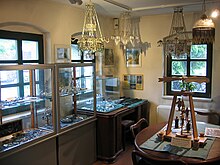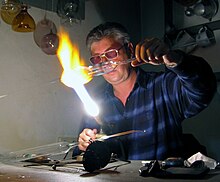Ore Mountains Glassworks Museum
The Ore Mountains Glassworks Museum is located in the former Fronfeste of Purschenstein Castle in Neuhausen / Erzgeb.
The museum shows, among other things, a glassworks from the time of Georgius Agricola , a workshop and other written and material evidence of the Erzgebirge glassmaking as well as the history of Neuhausen and the Purschenstein Castle. There are also demonstrations by glassblowers.
museum
The glassworks museum in Neuhausen houses testimonies of former glassmakers in the Ore Mountains, which go back to the settlement period around 1200 and include works from the Saxon and Bohemian Ore Mountains.
The importance of these glassworks extended far beyond the Ore Mountains region. This also applies to the former Neuhausen Glassworks Heidelbach, founded in 1488, which was active until around 1827 and which is shown in the exhibition.
In the Heidelbach glassworks, high-quality glass work was carried out in addition to simple utility glass and pane glass. The glassworks belonged to the purveyors to the court of Saxon electors and other noble houses. For the Purschensteiner castle chapel, the “The Four Evangelists” on display in the exhibition were made, four round glass panes painted with enamel from 1612.
The glassworks museum conveys an almost extinct, traditional trade. The exhibition shows the diversity of the material glass and its possibilities in terms of color, shape and processing. You can see utility glasses from historical times and special pieces, such as the round glass panes from 1612 and Ore Mountain chandelier spiders made from glass, which are over a hundred years old.
history
At the beginning of the 1990s, the Fronfeste of Purschenstein Castle, built in 1750, was listed as a historical monument. Thanks to subsidies, the house owned by the community was able to be renovated and converted into a museum together with the Erzgebirgszweigverein. In May 1996 the "Erzgebirge Glassworks Museum" opened with the first exhibition. It housed pieces from the 800-year history of glassmaking in the Ore Mountains.
The history of the Heidelbach glassworks from 1488 to 1827 is particularly reflected in the exhibition. In the meantime, the exhibition has been supplemented by a replica glass melting furnace in an adjacent building, which is intended to illustrate the production of glass vessels.
In May 2006 the anniversary was celebrated with a festival weekend. Since then there have been blown showings on public holidays. Replicas such as fly traps, Goethe barometers or Nuppe glasses are made. Nubs are typical glass decorations that shimmer in color and imitate precious stones and should increase the grip. Such glasses were used in higher circles in the late Middle Ages. The glass painting and engraving can also be seen on show days in the museum.
The unique of its kind museum in the Erzgebirge is looked after by a support group in the Erzgebirgszweigverein Neuhausen. On August 12th and 13th, 2002, during the flood of the century, this museum building, located on a mountain, was damaged by the water from the overflowing adjacent castle pond and was renovated and reopened thanks to a fundraising campaign.
In 2010/11, the museum's wooden shingle roof, which is in need of repair, will be completely renewed with state funding. The construction project was repeatedly postponed for several years because of the uncertain financing.
Glass making
The art of glassmaking and glass finishing, which is located in the Ore Mountains, was once in full bloom. In the Middle Ages there were more than 50 forest glassworks in the Saxon and Bohemian Ore Mountains. This led to a wealth of regional types and colors of glass.
With minerals that were already present in the raw materials, you only got a green colored glass. Decolorants formerly called »glassmaker's soaps« neutralized unwanted color casts. Additions of the mineral brownstone or arsenic make the glass appear colorless. Conversely, the glass was also colored in cobalt blue, purple, red, green or white.
The end of the Heidelbach glassworks around 1827 is primarily due to the outdated smelting technology and the strong competition from Bohemian glass at that time. Mining , metallurgy and also the wood art in the "Seiffener toy corner" increasingly deprived the glassmakers and glassworks of their livelihood due to a lack of firewood, which was needed in large quantities. The industrialization of glass production began in the Erzgebirge around 1880. In the early industrial age, there were important glassworks in Carlsfeld, Zwickau and Brand-Erbisdorf. When the glass furnaces in Carlsfeld were extinguished in 1979, the history of glassworks in the Saxon Ore Mountains ended.
literature
- About Olbernhau and Seiffen (= values of our homeland . Volume 43). 1st edition. Akademie Verlag, Berlin 1985.
- Albrecht Kirsche: Cistercians, glassmakers and turners - glassworks in the Ore Mountains and Vogtland and their influence on Seiffen wood art . Münster, New York, Munich, Berlin 2005.
Web links
Coordinates: 50 ° 40 ′ 38.86 " N , 13 ° 27 ′ 44.05" E




